Triggering of Land Subsidence in and Surrounding the Hangjiahu Plain Based on Interferometric Synthetic Aperture Radar Monitoring
Abstract
1. Introduction
2. Geologic Setting
3. Data and Method
3.1. Datasets
3.2. Methodology
4. Results
4.1. Distribution of Land Subsidence
4.2. Time Series of Land Subsidence
4.3. Precision Checking
5. Discussion
5.1. Natural Triggering of Land Subsidence
5.1.1. Neotectonic Movement
5.1.2. Surface Mass Loading
5.1.3. Seasonal Rainfall
5.2. Anthropogenic Triggering of Land Subsidence
5.2.1. Agricultural Production
5.2.2. Engineering Construction
6. Conclusions
Author Contributions
Funding
Data Availability Statement
Acknowledgments
Conflicts of Interest
References
- Galloway, D.L.; Burbey, T.J. Regional land subsidence accompanying groundwater extraction. Hydrogeol. J. 2011, 19, 1459. [Google Scholar] [CrossRef]
- Tongchun, Q.; Guoming, C.; Haigang, W. The latest progress of research on land subsidence abroad and its inspiration to China. China Inst. Geo-Environ. Monit. 2018, 37, 503–509. [Google Scholar]
- Huang, B.; Shu, L.; Yang, Y. Groundwater overexploitation causing land subsidence: Hazard risk assessment using field observation and spatial modelling. Water Resour. Manag. 2012, 26, 4225–4239. [Google Scholar] [CrossRef]
- Schmidt, C. Alarm over a sinking delta. Science 2015, 348, 845–846. [Google Scholar] [CrossRef] [PubMed]
- Zhang, Y.; Si, Z.; Lin, X.; Zhang, Z.; Chu, H.; Cao, C.; Liu, Y.; Huang, H.; Huang, B.; Bai, Z. Time-series InSAR reveals new insights into land subsidence in the Yellow River Delta, China. Mar. Georesour. Geotechnol. 2024, 1–10. [Google Scholar] [CrossRef]
- Bendarzsevszkij, A.; Eszterhai, V.; Gere, L.; Klemensits, P.; Polyák, E. World Economic Forum 2017. Int. J. Res. Eng. Sci. Manag. 2021, 4, 2. [Google Scholar]
- Kok, S.; Costa, A.L. Framework for economic cost assessment of land subsidence. Nat. Hazards 2021, 106, 1931–1949. [Google Scholar] [CrossRef]
- Liu, Z.; Ng, A.H.-M.; Wang, H.; Chen, J.; Du, Z.; Ge, L. Land subsidence modeling and assessment in the West Pearl River Delta from combined InSAR time series, land use and geological data. Int. J. Appl. Earth Obs. Geoinf. 2023, 118, 103228. [Google Scholar] [CrossRef]
- Lu, Y.; Chen, D.; Chen, Y. Analysis of Spatiotemporal Land Subsidence Patterns of Suzhou City, China, over the Past 15 years Based on Multisource SAR Data. J. Indian Soc. Remote Sens. 2022, 50, 1347–1369. [Google Scholar] [CrossRef]
- Liu, C.; Shi, B.; Gu, K.; Zhang, T.; Tang, C.; Wang, Y.; Liu, S. Negative pore water pressure in aquitard enhances land subsidence: Field, laboratory, and numerical evidence. Water Resour. Res. 2022, 58, e2021WR030085. [Google Scholar] [CrossRef]
- Guo, H.; Zhang, Z.; Cheng, G.; Li, W.; Li, T.; Jiao, J.J. Groundwater-derived land subsidence in the North China Plain. Environ. Earth Sci. 2015, 74, 1415–1427. [Google Scholar] [CrossRef]
- Dong, J.; Guo, S.; Wang, N.; Zhang, L.; Ge, D.; Liao, M.; Gong, J. Tri-decadal evolution of land subsidence in the Beijing Plain revealed by multi-epoch satellite InSAR observations. Remote Sens. Environ. 2023, 286, 113446. [Google Scholar] [CrossRef]
- Ye, S.; Xue, Y.; Wu, J.; Yan, X.; Yu, J. Progression and mitigation of land subsidence in China. Hydrogeol. J. 2016, 24, 685. [Google Scholar] [CrossRef]
- Wang, F.; Peng, J.; Lu, Q.; Meng, Z.; Qiao, J.; Zang, M.; Zhao, J. Development characteristics and dynamic mechanisms of tectonic ground fissures in Weihe Basin, China. Bull. Eng. Geol. Environ. 2022, 81, 12. [Google Scholar] [CrossRef]
- Li, X.; Zhang, X.; Qiu, C.; Duan, Y.; Liu, S.a.; Chen, D.; Zhang, L.; Zhu, C. Rapid loss of tidal flats in the Yangtze River Delta since 1974. Int. J. Environ. Res. Public Health 2020, 17, 1636. [Google Scholar] [CrossRef] [PubMed]
- Yueping, Y.; Zuochen, Z.; Kaijun, Z. Land subsidence and countermeasures for its prevention in China. Chin. J. Geol. Hazard Control 2005, 16, 1–8. [Google Scholar]
- Wu, J.; Shi, X.; Xue, Y.; Zhang, Y.; Wei, Z.; Yu, J. The development and control of the land subsidence in the Yangtze Delta, China. Environ. Geol. 2008, 55, 1725–1735. [Google Scholar] [CrossRef]
- Bagheri-Gavkosh, M.; Hosseini, S.M.; Ataie-Ashtiani, B.; Sohani, Y.; Ebrahimian, H.; Morovat, F.; Ashrafi, S. Land subsidence: A global challenge. Sci. Total Environ. 2021, 778, 146193. [Google Scholar] [CrossRef]
- Wu, H.; Zhang, Y.; Luo, G.; Mao, W.; Kang, Y.; Jin, Y. Ground subsidence monitoring over Jiaxing region, Zhejiang province from 2006 to 2010 using time series InSAR technique. Int. Arch. Photogramm. Remote Sens. Spat. Inf. Sci. 2015, 40, 181–184. [Google Scholar] [CrossRef]
- Jianyong, Y. The pain of sinking in the fertile wilderness. Zhejiang Daily 2005, 33-0001. [Google Scholar]
- Huizhen, S.; Jiankang, Z.; Sixiu, L.; Wei, L.; Mengjie, W.; Xiaoming, Z. The prevention of land subsidence on Hangjiahu plain. Shanghai Land Resour. 2014, 35, 114–117. [Google Scholar]
- Zhou, L.; Wei, B.; Chen, G.; Liu, S.; Li, X.; Luo, Z.; Qin, D.; Zhang, D. InSAR time series analysis of natural and anthropogenic coastal plain subsidence: A case of Hangjiahu plain. Geod. Geodyn. 2024. [Google Scholar] [CrossRef]
- Zhang, G.; Wang, S.; Chen, Z.; Zheng, Y.; Zhao, R.; Wang, T.; Zhu, Y.; Yuan, X.; Wu, W.; Chen, W. Development of China’s spaceborne SAR satellite, processing strategy, and application: Take Gaofen-3 series as an example. Geo-Spat. Inf. Sci. 2024, 27, 221–236. [Google Scholar] [CrossRef]
- Euillades, J.A.; Roa, Y.L.; Euillades, L.D.; Euillades, P.A.; Rosell, P.A.; Solarte, E.A.; Perna, S. Interferometric Assessment of SAOCOM-1 TOPSAR Data. IEEE Geosci. Remote Sens. Lett. 2023, 21, 1–5. [Google Scholar] [CrossRef]
- Chang, S.; Deng, Y.; Zhang, Y.; Zhao, Q.; Wang, R.; Zhang, K. An advanced scheme for range ambiguity suppression of spaceborne SAR based on blind source separation. IEEE Trans. Geosci. Remote Sens. 2022, 60, 1–12. [Google Scholar] [CrossRef]
- Bokhari, R.; Shu, H.; Tariq, A.; Al-Ansari, N.; Guluzade, R.; Chen, T.; Jamil, A.; Aslam, M. Land subsidence analysis using synthetic aperture radar data. Heliyon 2023, 9, 3. [Google Scholar] [CrossRef] [PubMed]
- Peng, W.; Huang, X.; Wang, Z. Coseismic deformation and fault inversion of the 2017 Jiuzhaigou Ms 7.0 Earthquake: Constraints from steerable pyramid and InSAR observations. Remote Sens. 2022, 15, 222. [Google Scholar] [CrossRef]
- Liao, J.; Liang, C.; Wang, C.; Cao, F.; Ye, C.; Yang, Y. Source Model for the 2022 Qinghai Menyuan Ms 6.9 Earthquake Based on D-InSAR. Front. Earth Sci. 2022, 10, 948661. [Google Scholar] [CrossRef]
- Hussain, M.A.; Chen, Z.; Khan, J. Monitoring land subsidence in the Peshawar District, Pakistan, with a multi-track PS-InSAR technique. Environ. Sci. Pollut. Res. 2024, 31, 12271–12287. [Google Scholar] [CrossRef]
- i Bassols, J.B.; Declercq, P.-Y.; Vàzquez-Suñé, E.; Gerard, P. PS-InSAR data, key to understanding and quantifying the hydromechanical processes underlying the compaction of aquifer systems. Case of West-and East-Flanders, Belgium. J. Hydrol. 2023, 624, 129980. [Google Scholar] [CrossRef]
- Zhang, Z.; Hu, C.; Wu, Z.; Zhang, Z.; Yang, S.; Yang, W. Monitoring and analysis of ground subsidence in Shanghai based on PS-InSAR and SBAS-InSAR technologies. Sci. Rep. 2023, 13, 8031. [Google Scholar] [CrossRef]
- Bateson, L.; Novellino, A.; Hussain, E.; Arnhardt, R.; Nguyen, H.K. Urban development induced subsidence in deltaic environments: A case study in Hanoi, Vietnam. Int. J. Appl. Earth Obs. Geoinf. 2023, 125, 103585. [Google Scholar] [CrossRef]
- Zhang, P.; Guo, Z.; Guo, S.; Xia, J. Land subsidence monitoring method in regions of variable radar reflection characteristics by integrating PS-InSAR and SBAS-InSAR techniques. Remote Sens. 2022, 14, 3265. [Google Scholar] [CrossRef]
- Wang, S.; Sun, H.; Wei, L.; Pi, P.; Zeng, M.; Pan, Y.; Xue, Z.; Jiang, X. Integrated Assessment of Coastal Subsidence in Nansha District, Guangzhou City, China: Insights from SBAS-InSAR Monitoring and Risk Evaluation. Remote Sens. 2024, 16, 248. [Google Scholar] [CrossRef]
- Dong, S.; Samsonov, S.; Yin, H.; Ye, S.; Cao, Y. Time-series analysis of subsidence associated with rapid urbanization in Shanghai, China measured with SBAS InSAR method. Environ. Earth Sci. 2014, 72, 677–691. [Google Scholar] [CrossRef]
- Huang, Z.; Wang, F.; Xie, B.; Yu, L.; Zhang, D. Monitoring Land Subsidence by Using Multi-temporal Differential SAR Interferometry: A Use Case in Jiaxing, China. In Proceedings of the 2008 International Workshop on Education Technology and Training & 2008 International Workshop on Geoscience and Remote Sensing, Washington, DC, USA, 21–22 December 2008; Volume 1, pp. 591–595. [Google Scholar]
- Zhang, Y.; Luo, G.; Mao, W.; Kang, Y.; Zhu, Y. Monitoring ground deformation in the Hangjiahu Plain using InSAR technique. In Proceedings of the MIPPR 2015: Remote Sensing Image Processing, Geographic Information Systems, and Other Applications, Enshi, China, 14 December 2015; Volume 9815, pp. 339–345. [Google Scholar]
- Wu, H.; Zhang, Y.; Luo, G.; Kang, Y.; Zhu, Y. Monitoring Ground Subsidence in Areas Covered by Dense Vegetation Using Terrasar-X Images: A Case Study of Hangzhou. Int. Arch. Photogramm. Remote Sens. Spat. Inf. Sci. 2016, 41, 55–59. [Google Scholar] [CrossRef]
- Han, P.; Yang, X.; Bai, L.; Sun, Q. The monitoring and analysis of the coastal lowland subsidence in the southern Hangzhou Bay with an advanced time-series InSAR method. Acta Oceanol. Sin. 2017, 36, 110–118. [Google Scholar] [CrossRef]
- Wang, R.; Feng, Y.; Tong, X.; Li, P.; Wang, J.; Tang, P.; Tang, X.; Xi, M.; Zhou, Y. Large-Scale Surface Deformation Monitoring Using SBAS-InSAR and Intelligent Prediction in Typical Cities of Yangtze River Delta. Remote Sens. 2023, 15, 4942. [Google Scholar] [CrossRef]
- Jiankang, Z.; Mengjie, W.; Sixiu, L.; Huizhen, S. The Relation between Groundwater Exploitation and Land Subsidence in the Coast Plain of Zheiiang Province. Geol. J. China Univ. 2006, 12, 185–194. [Google Scholar]
- Bai, L.; Yunbo, L.; Xiaowu, H. Implementation and Result Analysis of Level Monitoring of Land Subsidence in Hangiiahu Plain. Zhejiang Brig. Surv. Mapp. 2014, 30, 8–10. [Google Scholar]
- Yun, J.; Jiankang, Z.; Chuan, Z. Analysis of land subsidence and groundwater resources development and utilization in Jiaxing City, Zhejiang Province. Chin. J. Geol. Hazard Control 1998, 9, 36–41. [Google Scholar]
- Wei, Z. Crustal Deformation Monitoring and Mechanism Research in Hangzhou Area Based on D-InSAR. Ph.D. Thesis, Zhejiang University, Hangzhou, China, 2008. [Google Scholar]
- Boyang, D.; Jiqing, Y.; Fanli, M.; Haibing, L. The tectonics around Hangzhou and the fault’s influence on construction. J. Zhejiang Univ. Technol. 2003, 31, 319–323. [Google Scholar]
- Qi, Y.; Wei, Z.; Lin, L.; Zhijiang, M.; Lifeng, M.; Xiang, G. Characteristics of Spatial Distribution and Activities of the Changxing-Fenghua Fault in Hangzhou Bay. Geotecton. Et Metallog. 2010, 34, 40–47. [Google Scholar]
- Yanhui, M.; Wei, Z.; Jianyong, W. Application of Spatial Distribution of the Fault with Multi-resource Information -As an Example of Majin-Wuzhen Fault. Bull. Sci. Technol. 2013, 29, 110–113. [Google Scholar]
- Zhang, Y.; Huang, H.; Liu, Y.; Bi, H.; Zhang, Z.; Wang, K.; Yan, L. Impacts of soft soil compaction and groundwater extraction on subsidence in the Yellow River Delta. Mar. Georesour. Geotechnol. 2021, 39, 1497–1504. [Google Scholar] [CrossRef]
- Qiao, X.; Chu, T.; Tissot, P.; Holland, S. Sentinel-1 InSAR-derived land subsidence assessment along the Texas Gulf Coast. Int. J. Appl. Earth Obs. Geoinf. 2023, 125, 103544. [Google Scholar] [CrossRef]
- García, A.J.; Bakon, M.; Martínez, R.; Marchamalo, M. Evolution of urban monitoring with radar interferometry in Madrid City: Performance of ERS-1/ERS-2, ENVISAT, COSMO-SkyMed, and Sentinel-1 products. Int. J. Remote Sens. 2018, 39, 2969–2990. [Google Scholar] [CrossRef]
- Zhou, H.; Wang, Y.; Yan, S.; Li, Y.; Liu, X.; Zhang, F. Monitoring of recent ground surface subsidence in the Cangzhou region by the use of the InSAR time-series technique with multi-orbit Sentinel-1 TOPS imagery. Int. J. Remote Sens. 2018, 39, 8113–8128. [Google Scholar] [CrossRef]
- Shankar, H.; Chauhan, P.; Singh, D.; Bhandari, R.; Bhatt, C.; Roy, A.; Kannaujiya, S.; Singh, R.P. Multi-temporal InSAR and Sentinel-1 for assessing land surface movement of Joshimath town, India. Geomat. Nat. Hazards Risk 2023, 14, 2253972. [Google Scholar] [CrossRef]
- Fernández, M.; Peter, H.; Arnold, D.; Duan, B.; Simons, W.; Wermuth, M.; Hackel, S.; Fernández, J.; Jäggi, A.; Hugentobler, U. Copernicus Sentinel–1 POD reprocessing campaign. Adv. Space Res. 2022, 70, 249–267. [Google Scholar] [CrossRef]
- Yu, C.; Li, Z.; Blewitt, G.J.E.; Science, S. Global comparisons of ERA5 and the operational HRES tropospheric delay and water vapor products with GPS and MODIS. Earth Space Sci. 2021, 8, e2020EA001417. [Google Scholar] [CrossRef]
- Dong, J.; Zhang, L.; Liao, M.; Gong, J. Improved correction of seasonal tropospheric delay in InSAR observations for landslide deformation monitoring. Remote Sens. Environ. 2019, 233, 111370. [Google Scholar] [CrossRef]
- Florinsky, I.; Skrypitsyna, T.; Luschikova, O. Comparative accuracy of the AW3D30 DSM, ASTER GDEM, and SRTM1 DEM: A case study on the Zaoksky testing ground, Central European Russia. Remote Sens. Lett. 2018, 9, 706–714. [Google Scholar] [CrossRef]
- Dill, R.; Dobslaw, H. Numerical simulations of global-scale high-resolution hydrological crustal deformations. J. Geophys. Res. Solid Earth 2013, 118, 5008–5017. [Google Scholar] [CrossRef]
- Dehghani Bidgoli, R.; Zandi Esfahan, E.; Pirasteh-Anosheh, H. An investigation of Earth surface deformation by SBAS-InSAR analysis. Rend. Lincei Sci. Fis. E Nat. 2024, 35, 213–221. [Google Scholar] [CrossRef]
- Xu, Y.; Fan, H.; Dang, L. Monitoring coal seam fires in Xinjiang using comprehensive thermal infrared and time series InSAR detection. Int. J. Remote Sens. 2021, 42, 2220–2245. [Google Scholar] [CrossRef]
- ArmaÅŸ, I.; Gheorghe, M.; Lendvai, A.M.; Dumitru, P.D.; Bădescu, O.; Călin, A. InSAR validation based on GNSS measurements in Bucharest. Int. J. Remote Sens. 2016, 37, 5565–5580. [Google Scholar] [CrossRef]
- Tian, H.; Tao, Y.; Kou, P.; Alonso, A.; Luo, X.; Gong, C.; Fan, Y.; Lei, C.; Gou, Y. Monitoring and evaluation of gully erosion in China’s largest loess tableland based on SBAS-InSAR. Nat. Hazards 2023, 117, 2435–2454. [Google Scholar] [CrossRef]
- Fattahi, H.; Simons, M.; Agram, P.; Sensing, R. InSAR time-series estimation of the ionospheric phase delay: An extension of the split range-spectrum technique. IEEE Trans. Geosci. Remote Sens. 2017, 55, 5984–5996. [Google Scholar] [CrossRef]
- Fattahi, H.; Agram, P.; Simons, M. A network-based enhanced spectral diversity approach for TOPS time-series analysis. IEEE Trans. Geosci. Remote Sens. 2016, 55, 777–786. [Google Scholar] [CrossRef]
- Chen, C.W.; Zebker, H.A. Two-dimensional phase unwrapping with use of statistical models for cost functions in nonlinear optimization. J. Optim. Soc. Am. A 2001, 18, 338–351. [Google Scholar] [CrossRef]
- Yunjun, Z.; Fattahi, H.; Amelung, F.J.C. Small baseline InSAR time series analysis: Unwrapping error correction and noise reduction. Comput. Geosci. 2019, 133, 104331. [Google Scholar] [CrossRef]
- Berardino, P.; Fornaro, G.; Lanari, R.; Sansosti, E. A new algorithm for surface deformation monitoring based on small baseline differential SAR interferograms. IEEE Trans. Geosci. Remote Sens. 2002, 40, 2375–2383. [Google Scholar] [CrossRef]
- Jolivet, R.; Grandin, R.; Lasserre, C.; Doin, M.P.; Peltzer, G. Systematic InSAR tropospheric phase delay corrections from global meteorological reanalysis data. Geophys. Res. Lett. 2011, 38. [Google Scholar] [CrossRef]
- Jolivet, R.; Agram, P.S.; Lin, N.Y.; Simons, M.; Doin, M.P.; Peltzer, G.; Li, Z. Improving InSAR geodesy using global atmospheric models. J. Geophys. Res. Solid Earth 2014, 119, 2324–2341. [Google Scholar] [CrossRef]
- Jiageng, C.; Cunguo, C.; Li, W.; Bohui, L.; Yun, X. Earthquakes and neotectonic movements in Ningbo area. Acta Seismol. Sin. 1998, 20, 62–71. [Google Scholar]
- Huiming, H.; Liren, H.; Guohua, Y. Modern crustal vertical movements in the Yangtze River Delta and adjacent areas. Acta Geogr. Sin. 1992, 47, 22–30. [Google Scholar]
- Ke, D.; Xiaoying, G.; Wenqian, D.; Fuzong, C.; Wei, F.; Dingfa, H. Surface deformation characteristics of mass loading in the Sichuan-Xizang region. Sci. Surv. Mapp. 2023, 48, 28–42. [Google Scholar] [CrossRef]
- Chuanzhen, S. Characteristics of Non-Tectonic Crustal Deformation from Surface Loads around ChineseMainland and Correction Model. Ph.D. Thesis, Institute of Geology, China Earthquake Administration, Beijing, China, 2013. [Google Scholar]
- Dill, R. Hydrological Model LSDM for Operational Earth Rotation and Gravity Field Variations. 2008. Available online: https://gfzpublic.gfz-potsdam.de/pubman/faces/ViewItemOverviewPage.jsp?itemId=item_8770 (accessed on 19 May 2024).
- He, Y.; Nie, G.; Wu, S.; Li, H. Comparative analysis of the correction effect of different environmental loading products on global GNSS coordinate time series. Adv. Space Res. 2022, 70, 3594–3613. [Google Scholar] [CrossRef]
- Glomsda, M.; Bloßfeld, M.; Seitz, M.; Angermann, D.; Seitz, F. Comparison of non-tidal loading data for application in a secular terrestrial reference frame. Earth Planets Space 2022, 74, 87. [Google Scholar] [CrossRef]
- Huang, J.; Xian, Y.; Li, W.; Zhang, D.; Zhuang, X.M. Hydrogeochemical evolution of groundwater flow system in the typical coastal plain: A case study of Hangjiahu plain. Earth Sci. 2021, 46, 2565–2582. [Google Scholar]
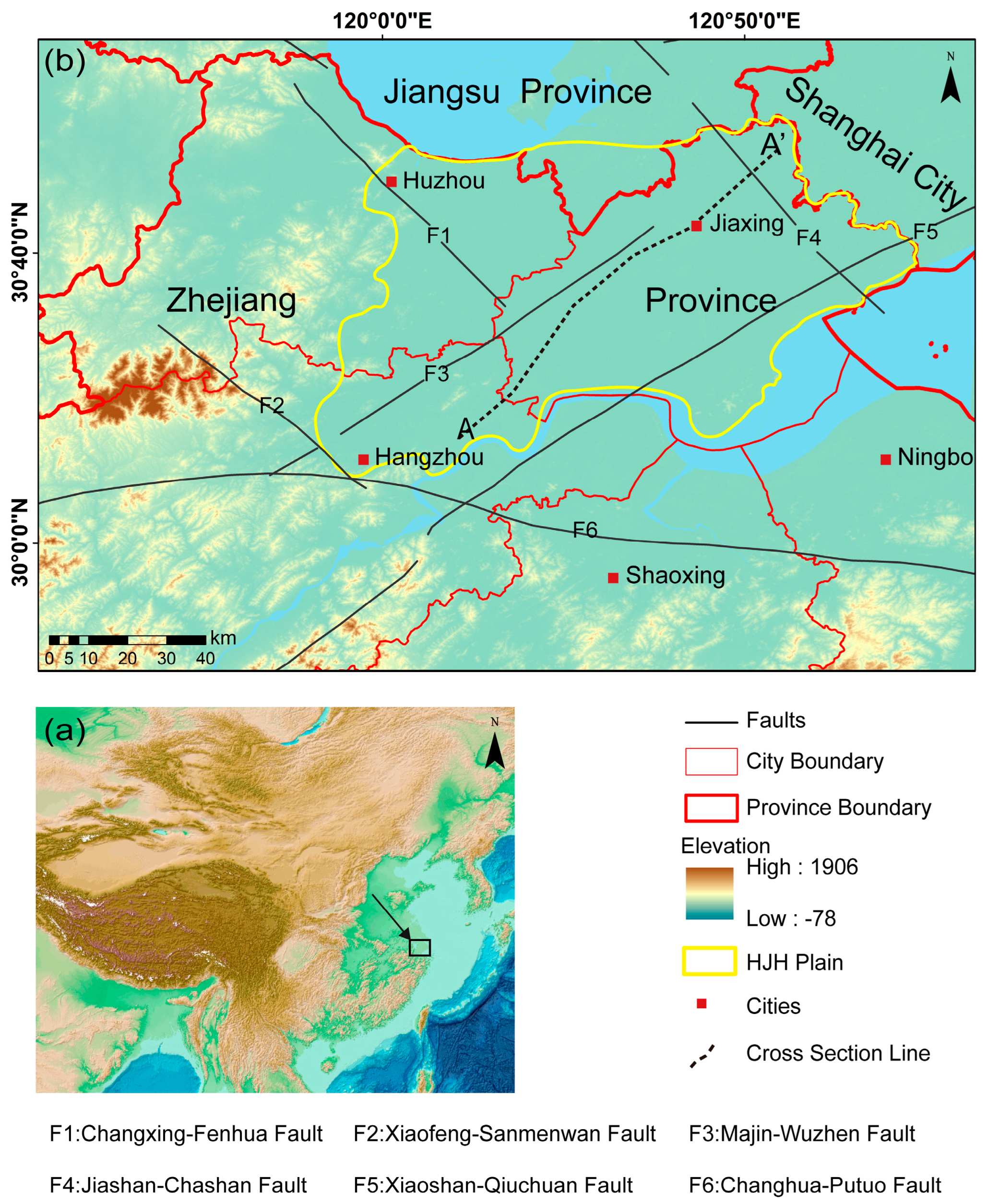









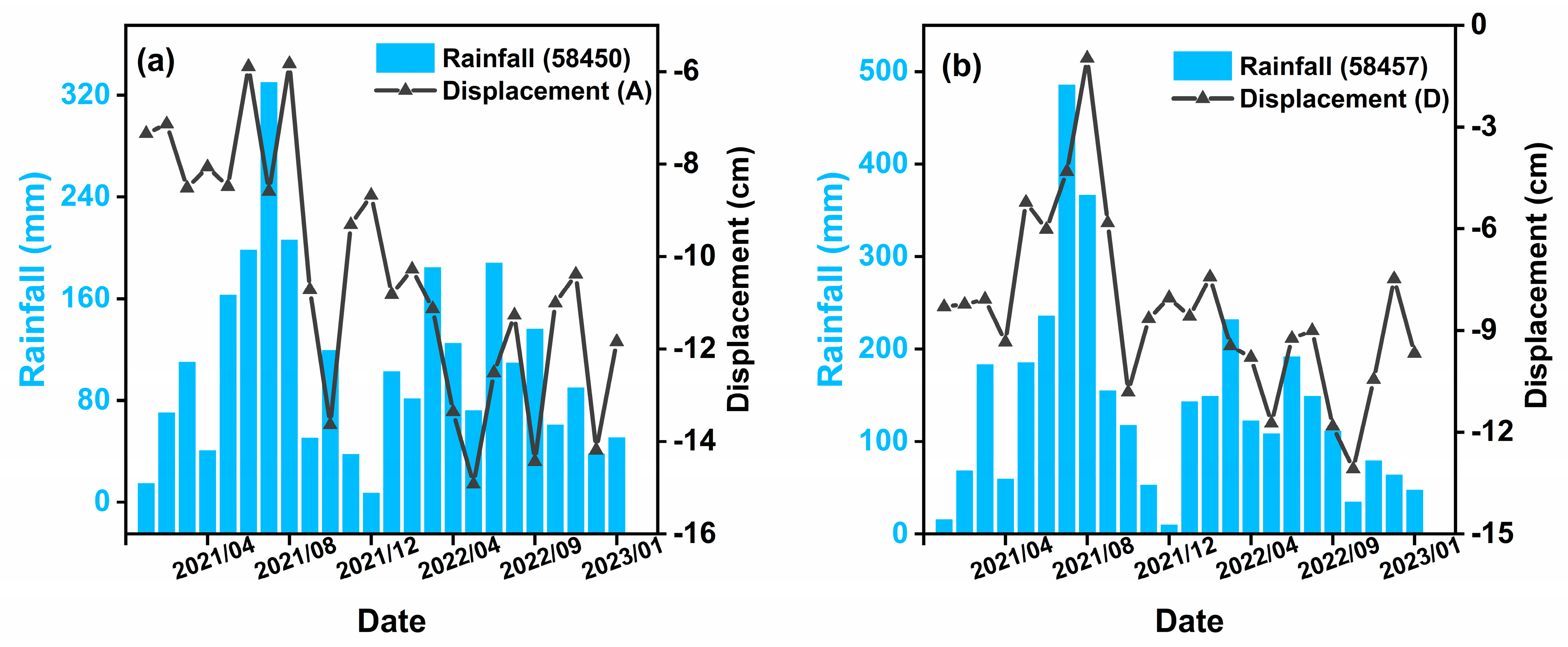
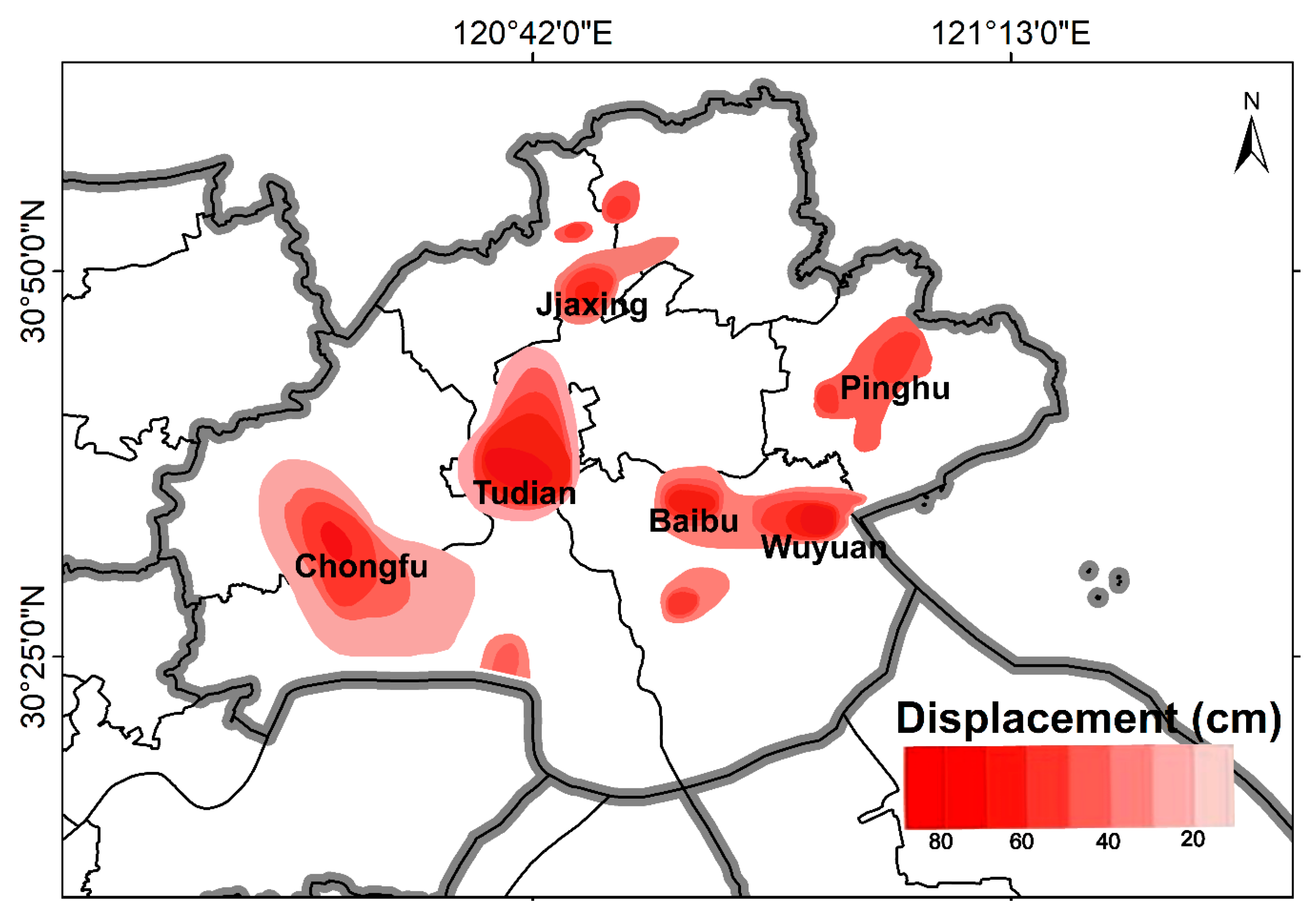




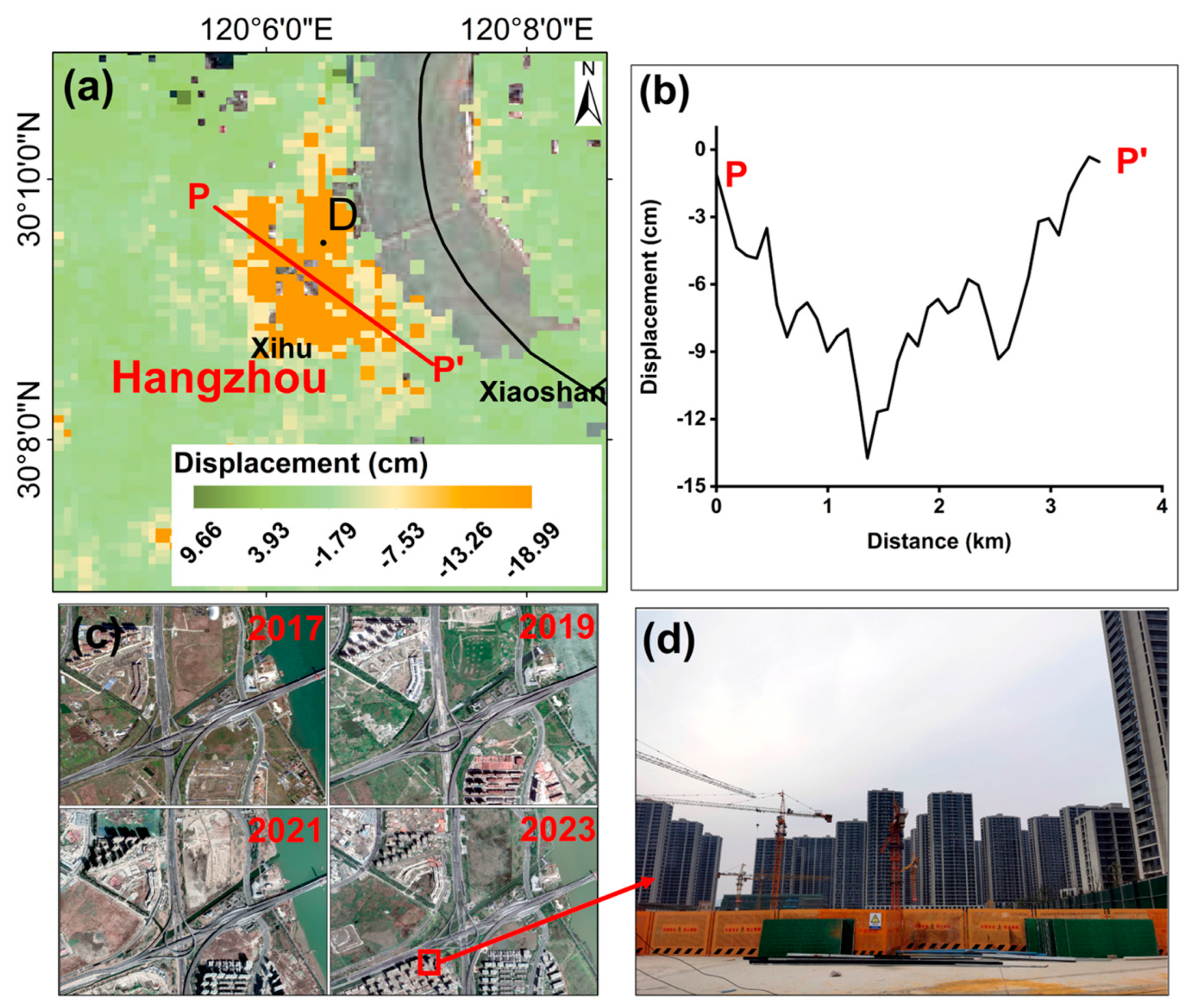
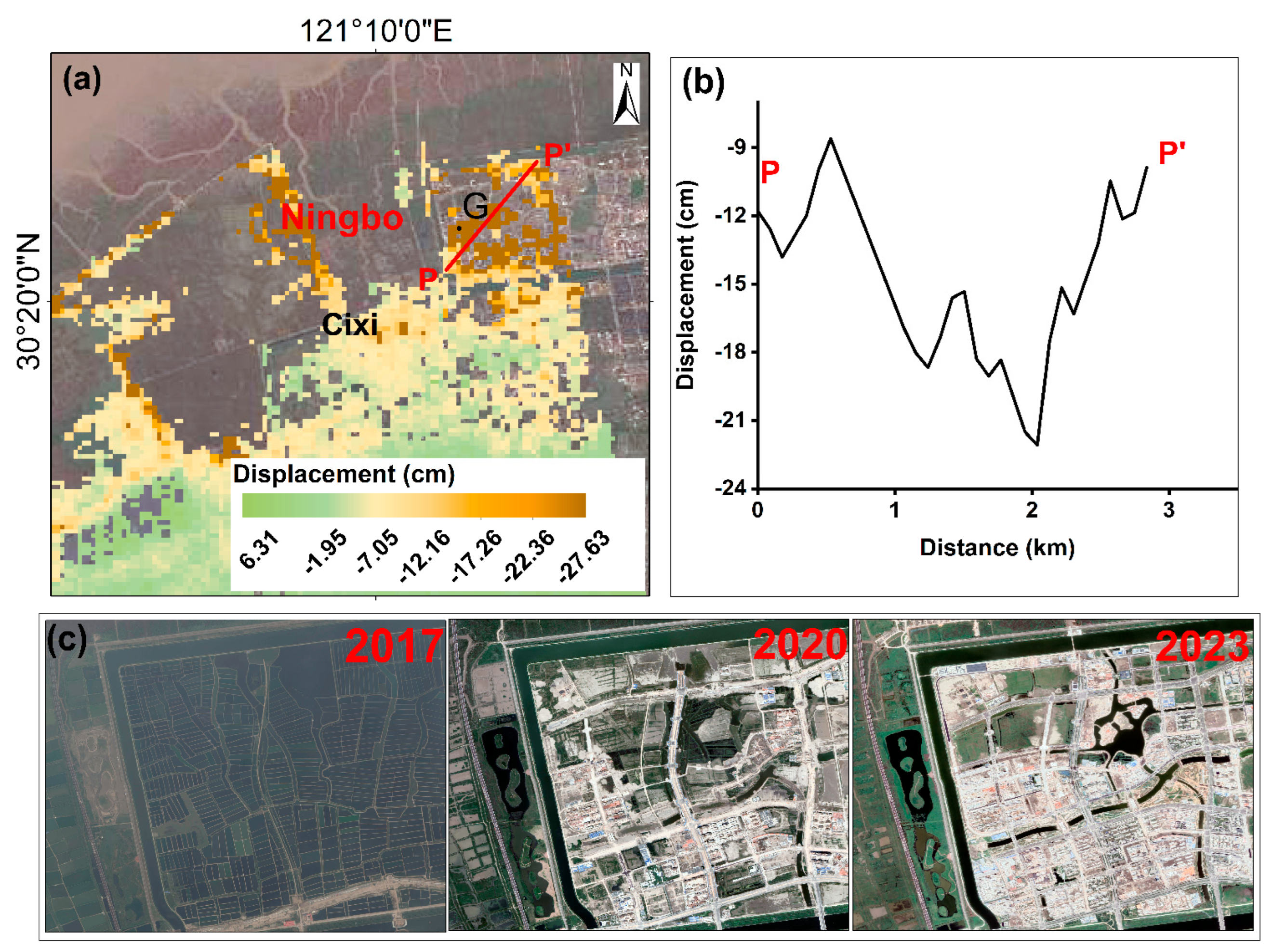
| Parameter | Value |
|---|---|
| Band | C |
| Wavelength [52] | ~5.55 |
| Incidence angle(°) | 39.66 |
| Path/Frame | 69/94 |
| Direction | Ascending |
| Sensor mode | IW |
| Polarization | VV |
| Time span | 16 March 2017–20 January 2023 |
| Number of images | 139 |
Disclaimer/Publisher’s Note: The statements, opinions and data contained in all publications are solely those of the individual author(s) and contributor(s) and not of MDPI and/or the editor(s). MDPI and/or the editor(s) disclaim responsibility for any injury to people or property resulting from any ideas, methods, instructions or products referred to in the content. |
© 2024 by the authors. Licensee MDPI, Basel, Switzerland. This article is an open access article distributed under the terms and conditions of the Creative Commons Attribution (CC BY) license (https://creativecommons.org/licenses/by/4.0/).
Share and Cite
He, Z.; Yang, Z.; Wu, X.; Zhang, T.; Song, M.; Liu, M. Triggering of Land Subsidence in and Surrounding the Hangjiahu Plain Based on Interferometric Synthetic Aperture Radar Monitoring. Remote Sens. 2024, 16, 1864. https://doi.org/10.3390/rs16111864
He Z, Yang Z, Wu X, Zhang T, Song M, Liu M. Triggering of Land Subsidence in and Surrounding the Hangjiahu Plain Based on Interferometric Synthetic Aperture Radar Monitoring. Remote Sensing. 2024; 16(11):1864. https://doi.org/10.3390/rs16111864
Chicago/Turabian StyleHe, Zixin, Zimeng Yang, Xiaoyong Wu, Tingting Zhang, Mengning Song, and Ming Liu. 2024. "Triggering of Land Subsidence in and Surrounding the Hangjiahu Plain Based on Interferometric Synthetic Aperture Radar Monitoring" Remote Sensing 16, no. 11: 1864. https://doi.org/10.3390/rs16111864
APA StyleHe, Z., Yang, Z., Wu, X., Zhang, T., Song, M., & Liu, M. (2024). Triggering of Land Subsidence in and Surrounding the Hangjiahu Plain Based on Interferometric Synthetic Aperture Radar Monitoring. Remote Sensing, 16(11), 1864. https://doi.org/10.3390/rs16111864







